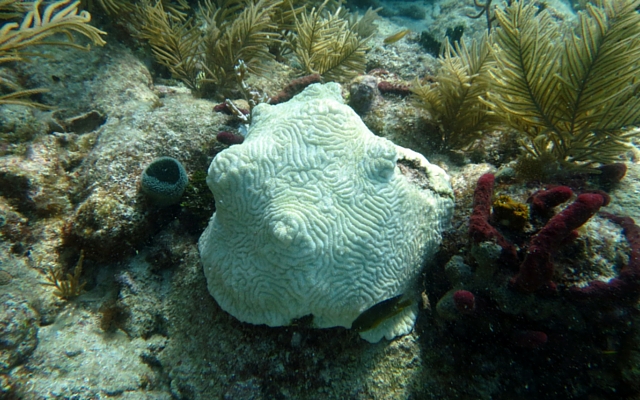Brain Coral (Diploria strigosa) in Juno Beach, FL suffering from White Plague, a disease that has ravaged coral reefs in the Western Atlantic.
[ad name=”HTML-68″]MIAMI — A mysterious epidemic continues to sweep South Florida’s reefs, transforming corals into lifeless skeletons and threatening undersea structures that support tourism, provide hurricane protection and serve as homes to a vast range of marine life.
Called white plague, white blotch and other names, depending on the pattern of damaged or destroyed tissue, the disease has infected more than 20 South Florida coral species from the Middle Keys through Palm Beach County, according to the Florida Department of Environmental Protection. On the reefs running from mid-Miami-Dade County through Martin County, scientists have observed a 35 percent loss of reef-building coral.
“The reef is in a state of emergency,” said Jennifer Stein, South Florida marine conservation coordinator for The Nature Conservancy. “It needs a lot of attention, a lot of research, a lot of focus, especially with this disease.”
The disease arose during a worldwide, three-year coral catastrophe called bleaching, in which unusually warm ocean water led many corals to expel the piece of algae that provided them with color and gave them a source of nutrition through photosynthesis. Although coral can recover from bleaching, the ordeal weakens them and makes them vulnerable to disease. Particularly hard hit was Australia’s famed Great Barrier Reef.
Despite the conclusion of the bleaching episode last summer, South Florida coral reefs have not recovered, with more and more corals falling victim to a disease that can kill within two weeks of infection. Scientists at universities, state and federal governments and environmental groups are racing to study the disease, in hopes of finding ways to stop it.
Corals are tiny animals that live inside skeletons they construct from minerals drawn from seawater. Generations of these skeletons form coral reefs, rocky structures built up over centuries, with a thin layer of living coral tissue on the surface.
Despite occupying only a tiny fraction of the footprint of the world’s oceans, coral reefs provide habitat for about a quarter of the world’s marine species. South Florida’s reefs, the only near-shore reefs in the continental United States, draw thousands of visitors for fishing, diving and snorkeling and provide homes to fish, crabs, lobsters, sponges, sea turtles and other creatures.
Since appearing in South Florida in late 2014, as corals were weakened by bleaching, the epidemic has spread quickly. A 35 percent loss of stony coral has taken place off the South Florida coast north of the Keys, judging from the losses seen at sites monitored by Nova Southeastern University, said David Gilliam, assistant professor of marine and environmental science at the university’s Halmos College of Natural Sciences and Oceanography.
“Stony corals are what creates the reef,” he said. “If you don’t have stony corals, you won’t have continued reef growth. If the reef isn’t growing, it’s slowly dissolving. Without growth, the coral will get lost, and that will affect the entire community, from reef fishes down to lobsters.”
Some species have virtually disappeared. Death claimed all but one of 65 colonies of pillar coral – rare, cucumber-shaped corals – being monitored from central Miami-Dade County to southern Palm Beach County, Gilliam said.
Very little is known about the disease, including whether it’s a single disease or related group of diseases. Scientists don’t know whether it’s caused by a bacteria, virus, fungus or other pathogen. They don’t know why it infects certain species and not others. They don’t know how to stop it. The state is spending $1 million this year to study it and the water conditions that surround it, with another $1 million coming next year, according to DEP.
The global bleaching episode may be what touched off the epidemic. In the Pacific, Indian and Atlantic oceans, tracts of once-colorful reefs turned a ghostly white. The bleaching was blamed on global warming and the temporary increase in ocean temperatures brought by El Niño, a periodic warming of the eastern Pacific Ocean. Last June, the coral bleaching episode was declared over by the National Oceanic and Atmospheric Administration.
“The good news is we didn’t have any more bleaching,” said Mark Eakin, coordinator of NOAA’s Coral Reef Watch program. “The bad news is we had disease that followed in the aftermath of the bleaching.”
In addition to bleaching, scientists say many other factors could have made corals vulnerable to disease, considering all the difficulties they face trying to survive along the heavily populated South Florida coast.
“The specific disease has not been identified and the causes can be difficult to determine because many factors contribute to coral disease rather than one distinct agent,” said Sarah Fangman, superintendent of the Florida Keys National Marine Sanctuary. “This is a worldwide issue and the subject of global study. We do know that reducing or eliminating local environmental stressors increases coral’s ability to fight disease and improves their likelihood of recovery and long-term survival.”
In South Florida, scientists say, the causes of stress to reefs are many and stem largely from the presence of millions of people, with their buildings, streets and sewage systems.
A paved landscape means rainwater washes into the ocean, bringing excess freshwater, fertilizers and anything else that can be carried from streets and parking lots. Inlets allow more freshwater and pollution into the ocean. Outfall pipes discharge treated into the ocean.
Beach widening projects heap the shoreline with sand, some of which washes into the ocean and clogs up corals. A project to deepen PortMiami stirred up sediment that caused extensive death along a coral reef, and a similar project is planned for Port Everglades.
“We have an ever-increasing population and an ever-increasing drive toward economic growth,” Gilliam said. “And all that leads to more stresses on the reefs, more port dredging, we have to maintain our beaches, more runoff associated with more people. I think it’s just reached the point where we have this disease event.”
https://reefs.com/2016/08/14/devastating-white-plague-coral-mortality-florida/


